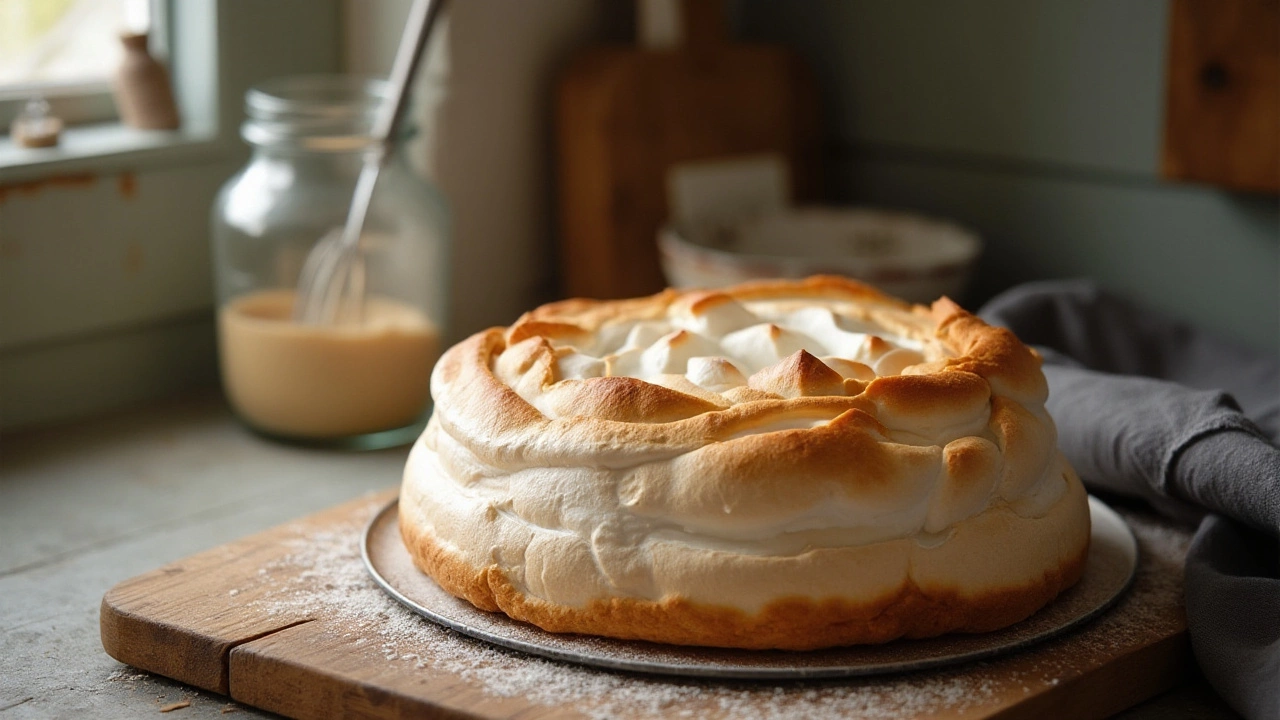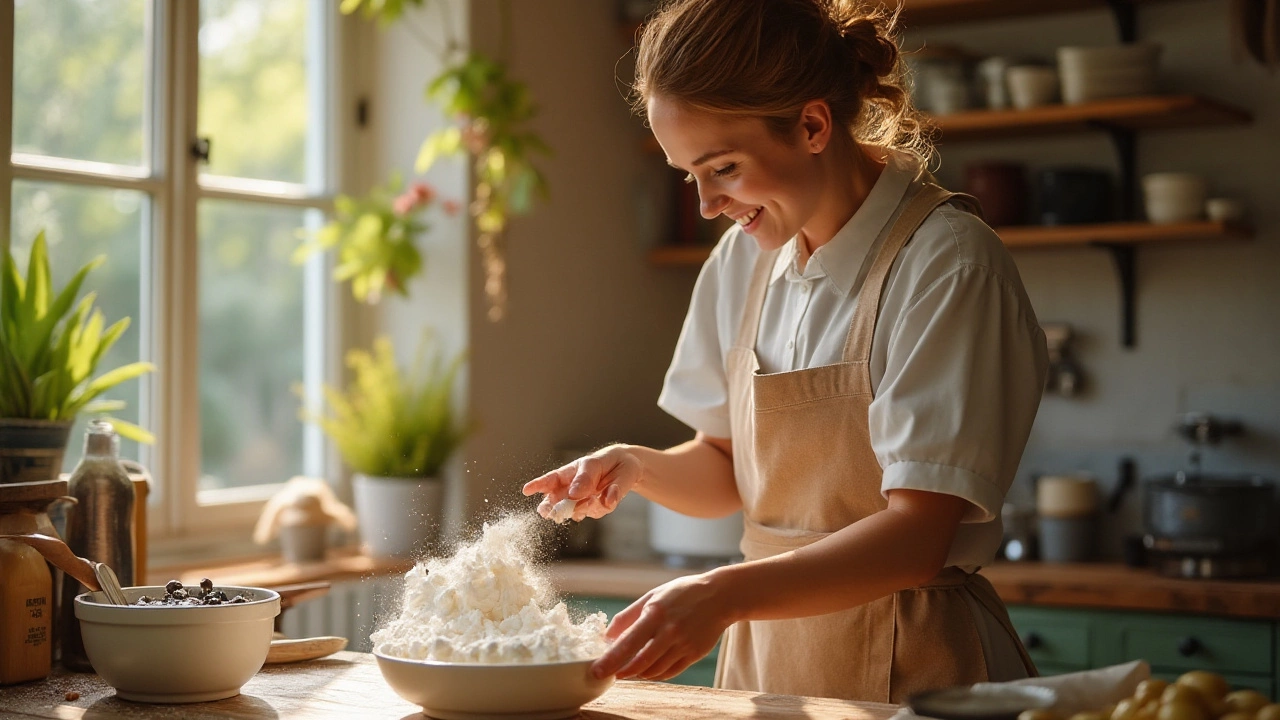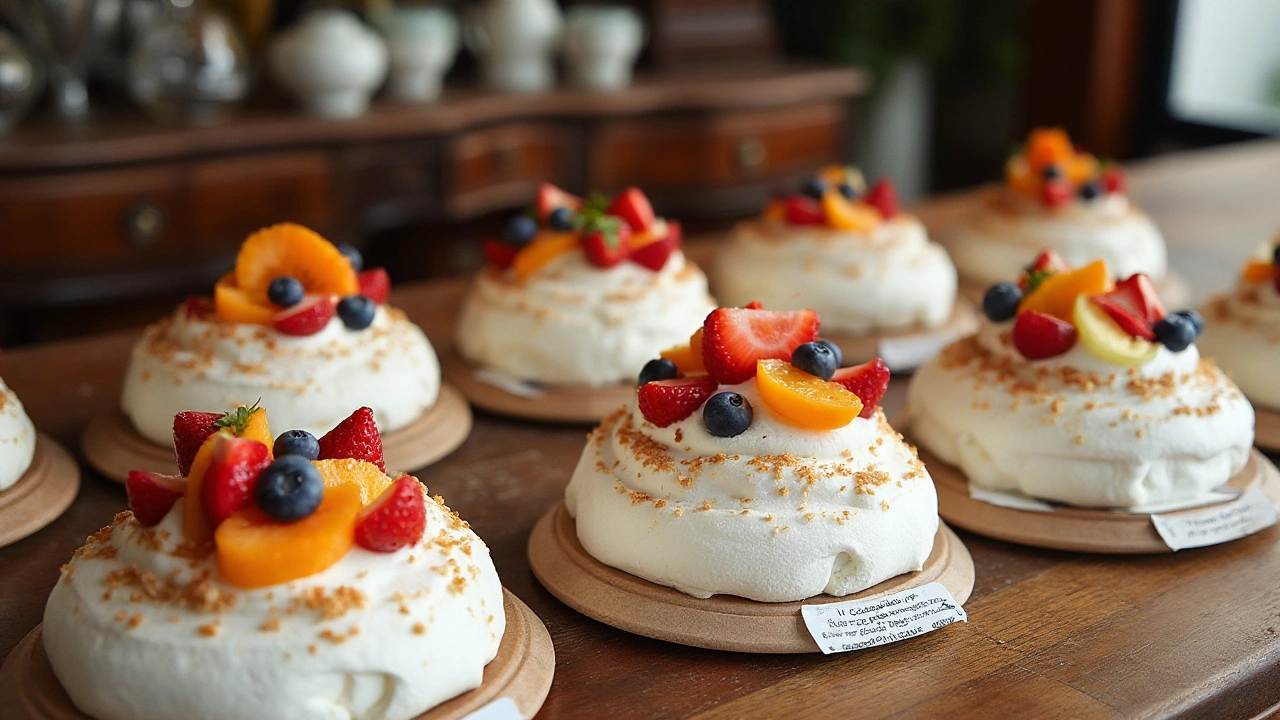
Pavlova is a dessert that both intrigues and enchants with its delicate meringue base, topped with whipped cream and fresh fruits. Yet, a question that often arises in baking circles is whether cornflour is a necessity for this light and airy sweet treat. While some recipes insist on the addition of this fine, white powder, others claim it's only a suggestion. But why does cornflour make it onto the ingredient list of so many pavlova recipes, and what happens if you leave it out?
Understanding the science behind cornflour in pavlova can unlock a world of baking possibilities. It serves a specific purpose – assisting in the stabilization of the egg whites during the baking process. This stabilization helps form the crisp shell on the exterior while maintaining a soft, marshmallow-like core. We'll explore how this versatile pantry staple works its magic, what alternatives exist for those with dietary or preference restrictions, and provide some useful tips to ensure your pavlova turns out perfect every time. So whether you're aiming for tradition or venturing into new flavors and textures, understanding the role of cornflour will elevate your pavlova game.
- Understanding Pavlova
- The Role of Cornflour
- Alternatives to Cornflour
- Common Mistakes and Tips
- Perfect Pavlova Recipes
Understanding Pavlova
To truly appreciate the nuances of making pavlova, one must first understand its origins and chemistry. Named after the Russian ballerina Anna Pavlova, pavlova captures the grace of its namesake with a combination of a crisp outer shell and a tender, marshmallow-like center. The dish was created in the early 20th century, with both Australia and New Zealand claiming its invention. This debate has persisted, fueling delightful culinary rivalries across continents.
The base of a pavlova is a meringue, a delicate creation born from beating egg whites to form stiff peaks, with sugar slowly incorporated to stabilize the mixture. This process creates a glossy, cloud-like substance that, when baked, forms the notable texture contrast pavlova is famous for. The most vital component here is the egg white, which relies on precise beating techniques to aerate, incorporating thousands of tiny air bubbles. These bubbles are what expand in the heat of the oven, turning the mixture into a voluminous beauty.
Adding sugar is not just about sweetness; its role is scientific, enhancing the foam's stability and creating the iconic crust by caramelizing during baking. Granulated sugar forms tiny air pockets essential for the crust's development. The way sugar interacts with egg proteins is a delicate dance that creates the structure of the meringue, making pavlova an ideal vehicle for culinary artistry. Surprisingly, a seemingly simple ingredient list consists of egg whites, sugar, and sometimes vinegar or lemon juice, with the potential addition of cornflour.
With its addition, cornflour enhances the structural integrity and chewy texture of the pavlova's interior. It acts as a stabilizing agent, ensuring the meringue holds its shape throughout the unpredictable baking process and provides a slight softness to the usually strict boundaries between the crust and interior. The inclusion of vinegar or lemon juice is primarily used to strengthen the proteins in the egg whites further, ensuring a stable structure for the meringue.
BBC Food aptly describes pavlova as "a simple, elegant dessert that shines with its toppings," a sentiment reflected in the propensity to crown it with whipped cream and a selection of seasonal fruits. While the base requires precision and care, the decoration offers a chance for creativity, with colorful fruits creating a visual delight that complements the neutral backdrop of the meringue. This combination of skillful precision and artistic flair makes pavlova not just a dish. It's an experience.
Creating a perfect pavlova is a rewarding venture, though not without its challenges. Identifying the right oven temperature and timing is crucial—too high, it browns too quickly; too low, it may not dry out properly—yet therein lies the joy of baking: the balance of science and creativity. Whether you're embarking on your first pavlova or refining your technique, understanding the underlying process is key to transforming simple ingredients into a masterpiece.
The Role of Cornflour
In the world of culinary arts, the seemingly simple ingredients often hold the key to creating masterpieces, and in the case of a pavlova, cornflour plays a vital role. Known for its ability to thicken and stabilize, cornflour is added to pavlova recipes to achieve that perfect balance of crispness and gooey softness that dessert lovers adore. When whipped with egg whites, sugar, and a dash of vinegar, cornflour works diligently to bind the moisture, forming a barrier that prevents the meringue from weeping or collapsing. This stability is essential in maintaining the distinct layers that set a pavlova apart from other meringue-based desserts.
Cornflour acts not just as a stabilizing agent but also as a texture enhancer. Its inclusion contributes to the iconic crisp crust, which protects the luscious marshmallow center beneath. Without cornflour, pavlovas may lack the structural integrity needed to hold toppings like whipped cream and fruits without becoming soggy. The engagement of cornflour in a pavlova recipe is akin to an artist applying the perfect brush strokes to their canvas. It's about reaching that beautiful synergy between the pillowy interior and the crunchy shell. Mary Berry, a celebrated figure in baking, once remarked that,
"The addition of cornflour ensures the ultimate pavlova, giving you that chewiness and crispness that defines a great version of this classic dessert."You might find varying opinions among bakers and chefs, yet many agree that while not absolutely mandatory, skipping cornflour requires astute adjustments elsewhere in the recipe.
It's interesting to note that different kinds of starch can play similar roles. However, cornflour is often preferred due to its fine texture and neutral taste, allowing the foundational flavors of the pavlova—egg whites and sugar—to shine unhindered. Cornflour isn't just an ingredient; it's an assurance of success, a secret keeper of the meringue's mysteries. For a pavlova that isn’t likely to fail you, this humble pantry staple is invaluable. While daring bakers may experiment with other options like potato starch or rice flour, it’s crucial to understand each has unique properties that might alter the dessert's final texture. In essence, many bakers find that the path to pavlova perfection leads through the inclusion of cornflour, making it a trusted ally in the kitchen.

Alternatives to Cornflour
While cornflour is a common staple in many pavlova recipes due to its ability to stabilize and add structure, there are situations where you might need or want an alternative. Whether for dietary reasons, a shortage in your pantry, or a baking experiment, several substitutes can maintain that perfect pavlova texture. One popular alternative is potato starch, known for its similar thickening ability and neutral taste. Like cornflour, it assists in creating the desired thickness without altering the flavor profile of your meringue. You can substitute potato starch at a 1:1 ratio with cornflour, offering similar results in terms of texture and moisture retention.
Tapioca flour, derived from cassava root, is another potential substitute. It's especially beneficial for those who are avoiding grain-based flours or are gluten-intolerant. It provides a glossy finish and a slightly chewier texture, which some bakers find enhances the meringue's appeal. Tapioca flour's absorbent nature helps manage humidity in pavlovas, an essential factor in maintaining that perfect crunch. For pavlova recipes, use it sparingly—start with half the amount of cornflour called for and adjust based on your preference and local climate conditions.
For bakers seeking a natural, protein-rich option, arrowroot powder is worthy of consideration. This gluten-free option offers similar stability but may impart a slight sheen to the meringue's surface. Some bakers note that arrowroot can also provide a slightly different mouthfeel, being softer than that achieved with traditional cornflour. Compensating for arrowroot’s lighter texture might mean adjusting baking times slightly—keeping a keen eye on color and consistency is key. These adjustments can ensure your pavlova maintains its iconic contrast between a crisp shell and tender inside.
In unique cases where a substitute is not handy, and the omission of cornflour seems inevitable, consider increasing the acidity of your meringue with a touch more vinegar or lemon juice. Acidic agents help stabilize egg whites, especially during whipping and baking. “Using a bit more acidity can help ensure the structural soundness of your pavlova, even without the buffer of starch,” suggests noted pastry chef [Chef Name]. Such adjustments can prove beneficial, particularly when pursuing a more natural ingredient list or catering to specific health needs without compromising on texture.
Exploring these alternatives can add a creative twist to your pavlova-making journey. Each substitute brings its nuances, perfect for experimenting with new flavors or catering to dietary restrictions. Always remember to adjust not just for taste but also for texture, as maintaining the pavlova's delicate balance is essential in achieving both visual and gastronomic excellence. Testing these alternatives in small batches first could be a wise move, helping you refine the process until you hit upon the perfect blend to suit your taste and aesthetic preferences.
Common Mistakes and Tips
Baking a perfect pavlova can sometimes feel like an elusive art, filled with potential pitfalls that can lead to a less-than-perfect dessert. One often-discussed mistake is overbeating the egg whites, which can lead to a dense texture rather than the airy lightness that pavlova is famous for. To avoid this, it’s crucial to beat the egg whites just until they reach stiff peaks but are still glossy, ensuring the air is trapped inside. Another common error is trying to bake when the oven temperature isn’t just right. The key is low and slow; baking too fast can cause the pavlova to crack.
Humidity is the enemy of pavlova. A damp baking day can lead to a sticky, weeping meringue. Baking your pavlova in a dry environment, and allowing it to cool completely in the oven, helps prevent this. One professional tip is to bake your pavlova the night before, turning off the oven and leaving it inside until morning. This gradual cooling process minimizes the risk of collapses and moisture absorption. According to baking expert Emma Dawson, "Let the meringue sit in the switched-off oven until it’s completely cool. Nature does its work when we’re patient." This approach aids in achieving the perfect crisp and chewy balance.
For the ambitious baker, it’s also important to perfectly balance the sugar. Too much sugar can cause the meringue to become gummy and chewy, losing its delicate crunch. However, using the right amount creates that desired crispy texture. Precision is key; use digital scales for accuracy and consistently test your mixture. Regarding stability, remember that cornflour should be gently folded in as the final step to preserve the texture. An overzealous hand can deflate those carefully whipped egg whites.
Apart from technique, having the right tools makes a significant difference. A clean, stainless steel or glass bowl is necessary since any grease can prevent the egg whites from reaching full volume. Rid your kitchen of any yolk; even a smidge can sabotage your meringue. Many people don’t realize how important the separating process is, so take care when cracking eggs. Additionally, avoid plastic bowls as their surface can hide traces of grease, even after washing.

Perfect Pavlova Recipes
The art of crafting a pavlova that transcends imperfections into sheer delight is a journey not merely limited to precise ingredient measurements but also reliant on technique and intuition. At the heart of every stellar pavlova lies its crispy exterior and chewy center, hovered by a delicate layer of fluffy cream and decorated with fresh fruits. To achieve such sublime textures and flavors, understanding the nuanced dynamics of each ingredient is imperative, with cornflour playing a pivotal role. This ingredient might seem minor, but its inclusion often makes the difference between blissful success and unanticipated collapse. By binding the liquid in the mixture, cornflour stabilizes the delicate balance, ensuring your pavlova retains its form and texture during and after baking.
Let's delve into the common, yet easily rectified, pitfalls many bakers encounter. Room temperature eggs create a firmer meringue, allowing for better air incorporation which is key to achieving that light marshmallow interior. Whisking until soft peaks form before gradually incorporating sugar helps the meringue to achieve gloss and stability. An important tip often overlooked is the slow addition of sugar; this should be a meticulous process, where the sugar dissolves entirely to avoid a grainy texture. Utilizing a stand mixer, if available, can assist significantly in this endeavor.
Once the sugar is perfectly enfolded, a touch of cornflour along with a splash of vinegar or lemon juice is added. The acidity from vinegar or lemon further aids in stabilizing the proteins within the egg whites, ensuring the meringue maintains both its aesthetic and structural integrity. If you’re seeking alternatives due to preference or dietary needs, potato starch or arrowroot can serve as substitutes while still preserving the desired texture. Experimenting with these alternatives can open a path to new flavor profiles and varied consistencies.
"The secret to a successful pavlova is patience," notes renowned pastry chef Alice Waters, emphasizing that every stage from the whisking to the baking demands time and attention. "Rushing through the steps can jeopardize the texture and appearance of this delicate dessert."
Once prepared and portioned onto a baking sheet, the meringue should be baked at a low temperature. This slow baking process allows for the exterior to dry to a crisp, while the interior remains soft. Baking times can vary by oven, with adjustments made as needed to account for oven variances. Some ovens may require pavlova to sit and cool inside to prevent cracking. Assembling the finished pavlova with layers of freshly whipped cream and fruit should be done just before serving to maintain the meringue's integrity.
A final advisable flexing of your creativity can involve drizzling the pavlova with syrups or a sprinkle of zest, adding further dimension to its tangy and sweet symphony. With these intricate layers of understanding, any passionate baker can transform a seemingly daunting recipe into a delightful experience. Like any great piece of art, the perfect pavlova combines both technical precision and the freedom of personal expression.